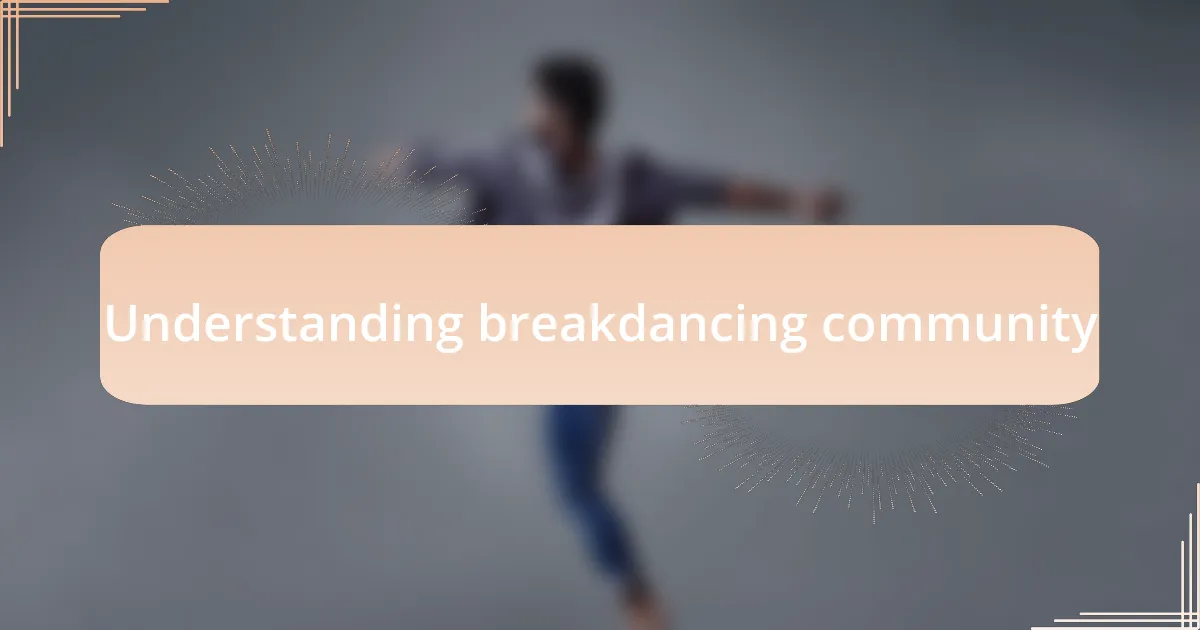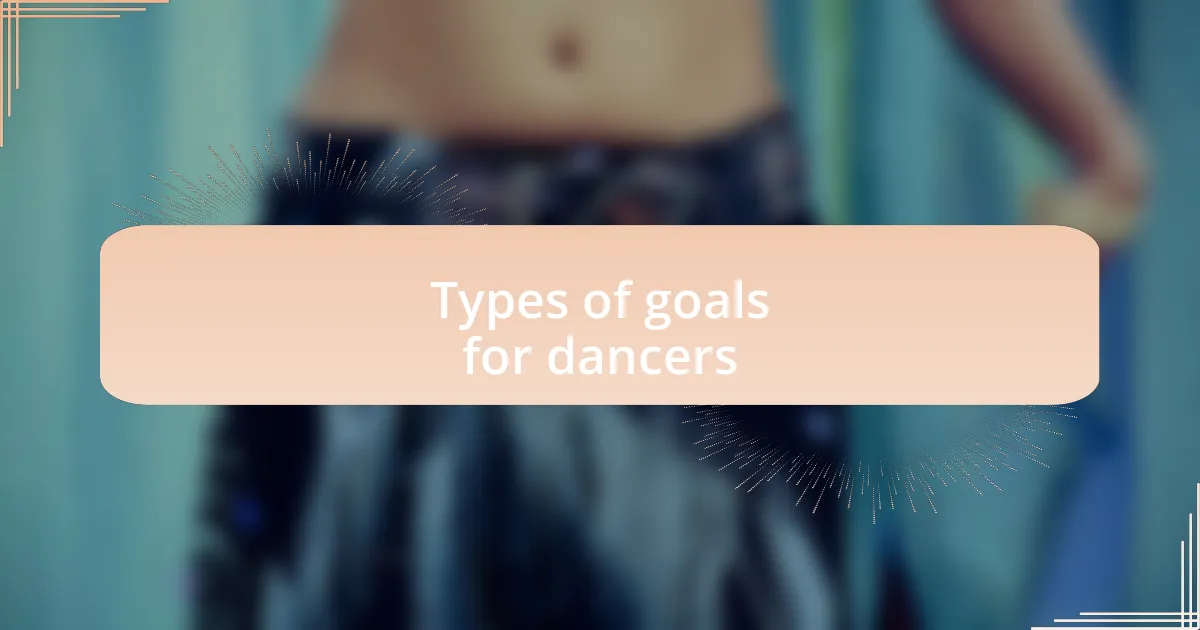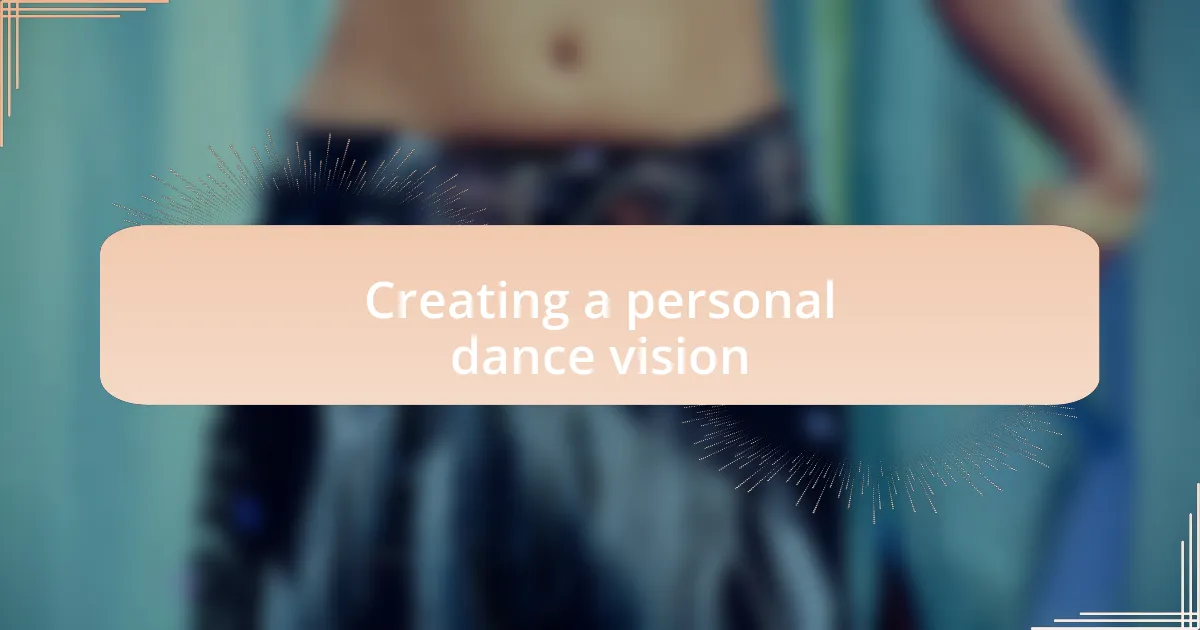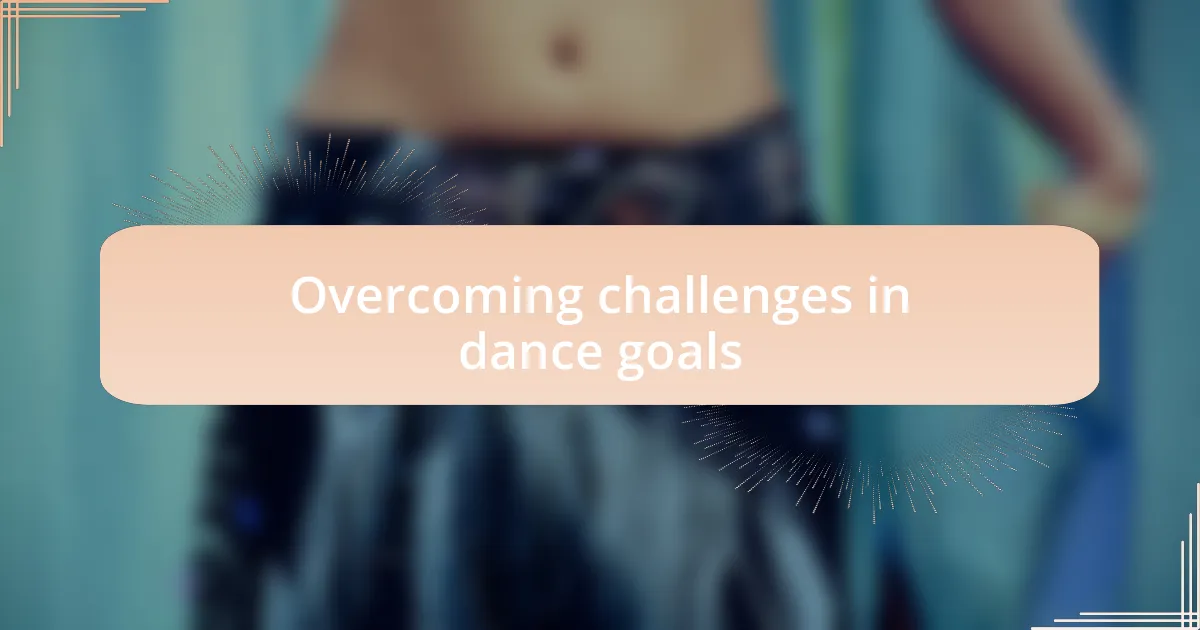Key takeaways:
- The breakdancing community fosters creativity, connection, and resilience, celebrating individual diversity while encouraging collective growth.
- Setting specific goals in dance provides direction, helps measure progress, and serves as motivation during challenges.
- Tracking progress through methods like dance journals and video analysis enhances accountability and aids in continuous improvement.
- Sharing goals with the community cultivates accountability and collaboration, leading to mutual encouragement and inspiration among dancers.

Understanding breakdancing community
The breakdancing community is more than just a group of dancers; it’s a vibrant ecosystem built on shared passion and creativity. I remember my first battle; the energy felt electric, and it was as if every person in the room was fueled by the same love for movement and expression. How often do you find a community that celebrates individuality while fostering collective growth?
When I think about my journey in this community, I realize it’s about connection. Each dancer brings their unique flavor, and that diversity is a powerful catalyst for inspiration. I’ve learned so much by simply watching seasoned b-boys and b-girls interact, exchanging tips and storytelling through dance—it’s a beautiful weaving of backgrounds and experiences.
Being part of this community has taught me resilience. There are moments of triumph, like nailing a difficult move, but also times of struggle where support from fellow dancers has made all the difference. Have you ever felt the encouragement of a friend push you beyond your limits? It’s precisely this camaraderie that makes the breakdancing community not just a space to dance, but a supportive family that nurtures growth and celebrates every milestone.

Importance of setting goals
Setting goals in my dance journey is crucial, as it creates a roadmap for achievement. I still recall the time I wanted to nail a headspin; without a clear goal, my practice sessions felt unstructured and unfocused. Have you ever felt like you were just going through the motions? By defining what I wanted to accomplish, my efforts became more intentional, transforming a daunting challenge into a series of manageable steps.
Moreover, having specific goals helps me measure my progress and celebrate wins, no matter how small. One time, I set a goal to improve my freezes. Each minor victory along the way, like holding a new position for longer, filled me with a sense of accomplishment. These moments boost my confidence and motivate me to push further. Isn’t it amazing how small successes can create a ripple effect in our personal growth?
Finally, goals serve as a source of inspiration during tough times. There have been days when I felt discouraged, wondering if I would ever master certain moves. But reminding myself of my goals reignited my passion and commitment. In those instances, I learned that goals not only guide my dance journey but also fuel my perseverance, helping me to rise above challenges and keep my love for breakdancing alive.

Types of goals for dancers
When it comes to setting goals, dancers often categorize them into different types. For instance, I frequently set skill-based goals, like mastering a particular move or improving my footwork. During one practice, I focused on refining my popping technique; pinpointing that goal made all the difference, allowing me to break it down into steps and steadily enhance my performance.
I also look at my dance journey through performance-oriented goals. This includes preparing for competitions or showcases, where the energy can be both exhilarating and intimidating. I remember the adrenaline pumping before my first battle—it was a mix of excitement and nerves. Setting a specific aim, like perfecting my routine for the event, helped channel my energy into something productive.
Lastly, I find that mindset goals hold significant value as well. These are not about the tangible moves but rather about building my confidence and fighting self-doubt. During times when I hesitated to express myself on the dance floor, setting intentions to embrace my individual style truly transformed my experience. It’s incredible how focusing on my mindset made me feel freer, mirroring the growth I’ve experienced throughout my dance journey. Have you ever realized how much your attitude can shift your performance?

Creating a personal dance vision
Creating a personal dance vision is essential for charting the course of my journey. I often begin by visualizing where I want to be in a year or even five years. For instance, during a quiet moment while stretching, I envisioned myself not just as a dancer but as someone inspiring others through my art. That vision sparks my passion and serves as a constant reminder of what I’m striving towards.
I’ve learned that incorporating my unique experiences into my vision is crucial. Reflecting on past performances, I remember a particular moment when I got lost in the music and felt an overwhelming connection to the crowd. It reminded me that my dance is more than just movement—it’s about expressing emotions and telling a story. How do you want your dance story to be told? Crafting this narrative has become a vital part of my personal vision, guiding me in selecting styles and techniques to explore.
In essence, my dance vision acts like a compass, steering me through challenges. For instance, I recall struggling with a series of complex spins that felt impossible. By focusing on my vision of performing fluidly and confidently, I found the motivation to break those moves down and practice them persistently. That connection between my goals and my vision fuels not only my dedication but also my resilience. What does your dance vision look like, and how does it inspire you on tough days?
![]()
Tracking progress in breakdancing
Tracking my progress in breakdancing is as crucial as the moves themselves. I keep a dance journal where I jot down my daily practices, including what worked and what didn’t. I remember one time after performing a new freeze; I couldn’t quite get the rotation I wanted. By reflecting on that experience, I focused my practice on strength training to build the endurance I needed.
When it comes to video recordings, they are a game-changer. Watching myself dance allows me to see the nuances I might miss in the moment. I recall the first time I filmed a session; I was surprised by how different my movements looked compared to how they felt. Analyzing these videos has helped me identify areas for improvement, and it creates a sense of accountability—not only to myself but to my dance community.
I also set small milestones to celebrate along the way. Achieving a clean headspin or nailing a challenging combo can feel incredibly rewarding! These achievements might seem minor, but they serve as stepping stones. What milestones are you setting for yourself, and how do they motivate you each day?

Overcoming challenges in dance goals
When facing setbacks in my dance journey, I’ve learned that perseverance is key. There was a moment when I struggled with my footwork, feeling like I was stuck in the same place for weeks. Instead of getting frustrated, I decided to break down each move and focus on one specific tweak at a time, which ultimately reignited my passion for improvement.
I often find that the mental challenges can be just as daunting as the physical ones. I vividly remember a performance where anxiety made it hard to execute my routines. That experience pushed me to incorporate visualization techniques into my practice. Have you ever tried imagining yourself flawlessly executing every move? It’s a simple yet powerful tool that helps transform fear into confidence.
Adapting my training methods has become essential whenever I encounter obstacles. For instance, when I faced injuries, I pivoted to studying dance theory and watching tutorials. This not only enriched my understanding but also kept my engagement with breakdancing alive. Have you ever thought about how learning from others can be just as impactful as physical practice? That realization opened new doors for me and made setbacks feel less like failures and more like opportunities for growth.

Sharing goals with the community
When I decided to share my dance goals with the community, I experienced an unexpected sense of accountability. Posting my objectives on social media not only motivated me but also invited support from fellow dancers who resonated with my aspirations. Have you ever found that sharing your journey with others creates a more profound commitment to your goals?
Collaboration with my peers has been a game changer. I vividly recall a session where I expressed my desire to master a challenging freeze. A friend immediately offered to work with me, sharing her own techniques and even some frustrations she faced along the way. This exchange reminded me that we all have our struggles, and by sharing our goals, we foster a culture of learning and encouragement.
When I attend local meetups or jam sessions, the energy of shared ambitions is palpable. It’s almost like a rhythm that we all move to; each goal articulated reinforces everyone’s motivation. One time, I listened to a newcomer express their dream of competing for the first time. This sparked discussions that not only inspired them but also reignited my own ambitions. Have you ever felt that rush from seeing someone else chase their dreams? It’s a powerful reminder that we’re all in this together.